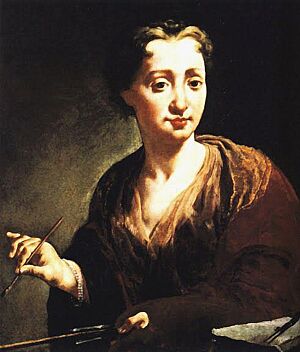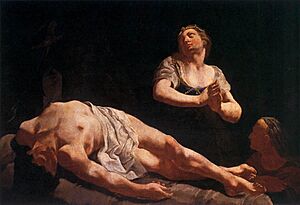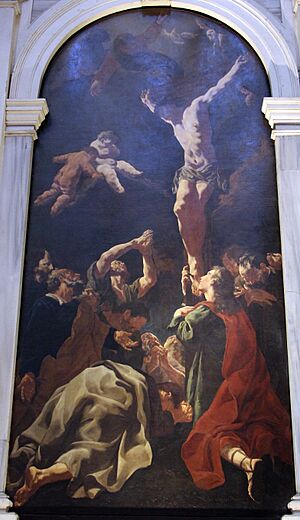Giulia Lama facts for kids
Giulia Elisabetta Lama (born October 1, 1681 – died October 7 or 8, 1747) was an Italian painter. She was very active in the city of Venice. Her unique style used dark, strong colors. This was different from the soft, light colors popular during the late Baroque art period.
Contents
Biography
Giulia Lama was born in Venice, Italy. Her family lived near the Santa Maria Formosa church. Her parents were Agostino Lama and Valentina dell'Avese. Giulia was the oldest of four children. She had two brothers, Niccolò and Pietro, and a sister, Cecilia.
Giulia first learned to paint from her father, Agostino Lama, who was also a painter. She later studied with her childhood friend, Giambattista Piazzetta. They both learned at the school of Antonio Molinari in Venice. Because they studied together, their painting styles were similar. They both used a technique called chiaroscuro. This means using strong contrasts between light and dark to create a dramatic effect.
A letter from 1728 tells us more about Giulia. It says that other painters tried to cause trouble for her. But she was strong and successful despite them. The letter also mentions that she was very smart and spoke well. Besides painting, Giulia was good at math, writing poetry, and making lace.
Giulia Lama spent most of her life in Venice. She was a successful painter of historical scenes and portraits. She also wrote poetry. She passed away in October 1747. It is thought she might have died from the plague.
Giulia was a highly skilled artist. She could paint gentle portraits, like Young Man with a Turban. She also created large, important artworks, such as altarpieces. These were big paintings for church altars. Finding her works has been a challenge. Many of her paintings were mistakenly thought to be by other artists. These include Piazzetta, Federico Bencovich, and Domenico Maggiotto.
Education
Giulia Lama started her education early in life. Her father, Agostino Lama, taught her math and art. At that time, it was hard for women in Venice to study science. But Giulia still followed her interest in math. She even studied with a famous mathematician named Padre Maffei.
Sources also suggest that Giulia might have learned lace making. This skill could have helped her earn money. She was also known for her embroidery. A letter from Antonio Schinella Conti mentions her interest in machines for making lace.
Giulia never married. She found ways to be financially independent as a woman. This was quite unusual for her time.
After her father's training, Giulia's formal art education is not fully clear. Some sources say she might have been taught by Giuseppe Angeli. She studied alongside other artists like Francesco Cappella and Domenico Maggiotto. They all attended the school of Antonio Molinari in Venice.
Over 200 of Giulia's early sketches have been found. These drawings show her studies of the human body. She often visited the Venetian Arsenal. This was a large shipyard. It is likely she observed workmen there to study male figures for her art.
Career
Giulia Lama had a successful career as a painter. She received many painting jobs, called commissions. These came from both private people and public places like churches.
In 1726, another writer, Luisa Bergaiii Gozzi, praised Giulia's achievements. She wrote that Giulia was a very smart painter. She said that important churches wanted her artworks, especially her altarpieces. This shows how respected Giulia was for her painting style.
In 1722, Giulia received an important commission. She was asked to paint an altarpiece for her local church, Santa Maria Formosa. Around 1750, she got another big job. This was to paint a scene of the Crucifixion for an altar in the San Vidal church.
Works
Self-portrait

In her self-portrait, Giulia Lama is shown at 45 years old. She holds a paintbrush and a palette. She chose to dress in simple clothes. She wears a pearl bracelet on her wrist.
The Martyrdom of Saint Eurosia
Giulia Lama's painting of Saint Eurosia was displayed in a church or chapel. The painting is now part of the Ca' Rezzonico Museum collection. It was donated to the museum in 1962.
Judith and Holofernes
Giulia Lama created two versions of the painting Judith and Holofernes. The first version was made around 1725. It is now in the Galleria dell'Accademia in Venice. She painted a later version in 1735. This second painting is in a private collection in Milan.
Poetry
Giulia Lama was also a poet. While we don't have many of her poems, we know she wrote some songs, sonnets, and a eulogy. A eulogy is a speech or writing that praises someone who has died. She wrote one to honor her friend, Abbot Antonio Sforza, after he passed away.
Death
Records suggest that Giulia Lama died on October 8, 1747. She was about 66 years old. The record states she had a fever and skin disease that led to convulsions. She was buried at the Church of Santi Giovanni e Paolo in Venice.



